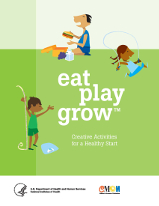Smart Sleep!
Early Childhood Health Lesson
Objective:
Learn the importance of getting healthy sleep.
We Can! Message
Healthy sleep plays a vital role in maintaining a healthy body and mind.
National Pre-K–2nd Grade Health Performance Standards
Identify that healthy behaviors impact personal health.
Adult Messages
Sleep is essential for children and adults to function.
Sleep is as important as nutrition and physical activity.
Children who get optimal sleep tend to have fewer problems with mood swings and irritability;
less behavioral consequences such as hyperactivity, aggressiveness, and poor impulse control;
and increased learning and academic success. Moreover, sleep has also been shown to lower
the risk for the development of obesity, diabetes, potential long-term cardiovascular effects,
impaired growth, poor immune function, and accidental injuries.
Developing Preschool Readiness Skills
Learn counting skills, dramatic play, body awareness, and gross motor development.
Program Content
Themed lesson plans incorporating art, literacy, movement and music support a multi-disciplinary approach to teaching young children and adults.
Program Length: 70 minutes
Introduction/Discussion
Materials: Name stickers, markers
Welcome families with name stickers and “hello” song. Ask children and parents what they
think happens while we sleep. Many will think that the body “stops.” It is important to help
them realize that while your body is taking a rest from the day it is, in fact, still working. Your
heart continues to pump, the body moves while sleeping, and the brain is active—having
dreams, sorting out the days events, allowing your mind and body to “re-charge.” Engaging
children in a conversation about dreams, bad and good, will help them realize that dreams are
a natural part of sleeping.
Discuss with families what it feels like when you don’t get a good night’s sleep and when you do. Return to the importance of sleep by asking children (and adults) what it feels like when you are tired or when you are with someone who has not had enough sleep (grumpy, sluggish, sick, etc). Discuss the benefits of a good night's sleep: it helps you learn better, feel better—both physically and mentally—and helps you make better decisions (including eating decisions)!
Setting the stage for your best possible sleep is also important! Discuss the important components of healthy sleep for children and families: regular bedtime, consistent bedtime over weekday and weekend nights, regular wake up time, bedtime routine, no electronics in the bedroom, no caffeine, avoiding negative messages about sleep (“if you’re bad, you have to go to bed”). Lead a conversation about what families like to do before going to bed and list the best thing about sleeping (dreams? soft bed? lullabies?) Help families create a bedtime routine to help them sleep better and wake up refreshed and ready for the new day.
Visual References: Sleepy Meter.
Key Teaching Messages
- 1–3 year olds need about 12–14 hours of sleep in a 24-hour period.
- 3–5 year olds need about 11–13 hours of sleep each night and most do not nap after 5 years of age.
- Adults need around 8 hours of sleep every night.
- Sleep is a time for the body to perform functions that only occur while sleeping (hormone regulation).
- Nothing replaces sleep but sleep.
- Sleep is just as important to children’s health and development as nutrition and physical activity.
- Sleep helps the body perform at its best during the day.
- Inadequate sleep has many negative results in children and adults, optimal sleep has many benefits.
- Inadequate sleep can affect body weight by affecting: healthy eating decisions, body’s ability to use and break-down food, and body’s ability to perform growth processes.
- Parents can make small changes in sleep habits that have a big impact (and it’s free!)
Art Activity: Sleep Mobile
Materials: Pre-cut cardboard arches, pipe cleaners, glue, large craft sticks, collage materials (fabric, foam shapes), and yarn.
Set-up: Place one cardboard arch at each seat. Spread the pipe cleaners (all different colors) across the table. Next, pass out the glue. Fill cups halfway full and place one cup of glue at each seat, as well as a craft stick. Spread one to two handfuls of collage materials across the table. Encourage children to attach foam core shapes, fabric, and/or other materials to the end of the pipe cleaners and then attach them to the wire hanger. Discuss with children what they would like to look at as they go to sleep at night. When children are finished with their sleep mobiles, place the project in a place to dry. Use a marker to write the child’s name on a strip of tape and attach it to the wire hanger.
Clean-up: Give children a 5 minute warning. Always let children know that you will be transitioning and ending the project soon. After the warning, sing a clean-up song to focus children and encourage participation in the clean-up process. One example: “Clean up, clean up, one, two, three. I’ll help you and you help me. Clean up, clean up, one, two, three. I’ll help you and you help me.”
Physical Activity: Movement/Music
Weekly Structure: Warm-up, Active Play Time, Movement/Music (song/activity), Cool-down. Children should do at least 60 minutes (1 hour) or more of physical activity each day.
Warm-up:
Marching Movement Song
We’re marching, marching, marching
We’re marching in a circle
We’re marching, marching, marching until it’s time to stop!
We’re jumping, jumping, jumping
We’re jumping in a circle,
We’re jumping, jumping, jumping until it’s time to stop!
(add hopping, stomping, running, tiptoeing, etc.)
In and Out Circle Song
Let’s go in and in and in
And out and out and out
And in and in and in and in
And out and out and out!
Active Play Time:
Do 5 or 10 minutes of each exercise
- Playing Tag
- Hopscotch
- Jumping Jacks
- Jumping (one foot, together then apart, front to back)
Movement/Music:
Scarf dancing with jazz and/or classical music, using rhythmic and stretching movements. Do yoga, stretching, and deep breathing to calm down and talk about a routine they could do to relax before bed. Also practice feeling tension and release. This helps our muscles relax.
Cool-down:
It is important for the body to cool down gradually.
- Breathing–Place hands on belly or lower back. Inhale and fill the lungs. Feel the abdomen and ribs inflate. Exhale and empty the lungs. Feel the chest and abdomen relax.
- Yoga Moves
- Downward Dog–Have the children make a bridge with their bodies. From here you can kick one leg up at a time and start to stretch body long.
- Tree Pose–Have the children balance on one leg, bending their other leg at a 90 degree angle, stretching their hands above their heads.
- The Horse–Stand in place for 30 seconds with a wide stance and knees bent (like a halfway down squat position).
Group Storytime
Goodnight Moon by Margaret Wise Brown
Time to Sleep by Denise Fleming
Good Night, Gorilla by Peggy Rathmann
Healthy Snack
Offer unsweetened applesauce and fat-free or low-fat milk as healthy bedtime snacks. An educator-led discussion will give children and adults the opportunity to discuss strategies for creating healthy bedtime snacks.
Encourage children to wash hands with soap and warm water before eating snack. Hand Washing Strategy: Wash hands for 20 seconds to fight off all germs and then rinse well under running water. Sing the ABC Song while you wash.
Review Family Handout
Goal: Develop a family bedtime routine!
Fact of the Week: 1–3 year olds need about 12–14 hours of sleep in a 24-hour period. 3–5 year
olds need about 11–13 hours each night and most do not need naps after 5 years of age.
At-Home Strategies:
- Create a routine for bedtime, including a regular sleep schedule, regular routine, and regular sleep environment.
- Create proper sleep environment that is dark, quiet, and comfortable.
- Activity during the day helps the body sleep well.
- Do not watch TV or movies, especially scary ones, close to bedtime.
Lesson Visuals
- Sleep Meter
Lesson has been reviewed by CMOM Health Advisor Dr. Judith Owens, M.D., M.P.H., Director of Sleep Medicine at Children's National Medical Center, Washington D.C., November 2012
Family Health Handout
Smart Sleep!
Benefits of Sleep:
- Body restores itself during sleep.
- Increases brain’s ability to focus, learn, and think clearly.
- Helps boost immune system which helps fight sickness.
- Active period of bodily growth and repair.
Farmers Market or Green Cart Shopping List
Pick up a banana—a healthy bedtime snack—at your local market!
Family Goal
Goal: Develop a family bedtime routine! Use this nighttime checklist:
Monday
Family Goal
Take a warm bath
Brush teeth
Place a cup of water by the bed
Share the best part of the day
Read a story together
Turn on the night-light
Sing a lullaby
Give a hug or kiss goodnight
Give a backrub
Tuesday
Family Goal
Take a warm bath
Brush teeth
Place a cup of water by the bed
Share the best part of the day
Read a story together
Turn on the night-light
Sing a lullaby
Give a hug or kiss goodnight
Give a backrub
Wednesday
Family Goal
Take a warm bath
Brush teeth
Place a cup of water by the bed
Share the best part of the day
Read a story together
Turn on the night-light
Sing a lullaby
Give a hug or kiss goodnight
Give a backrub
Thursday
Family Goal
Take a warm bath
Brush teeth
Place a cup of water by the bed
Share the best part of the day
Read a story together
Turn on the night-light
Sing a lullaby
Give a hug or kiss goodnight
Give a backrub
Friday
Family Goal
Take a warm bath
Brush teeth
Place a cup of water by the bed
Share the best part of the day
Read a story together
Turn on the night-light
Sing a lullaby
Give a hug or kiss goodnight
Give a backrub
Saturday
Family Goal
Take a warm bath
Brush teeth
Place a cup of water by the bed
Share the best part of the day
Read a story together
Turn on the night-light
Sing a lullaby
Give a hug or kiss goodnight
Give a backrub
Sunday
Family Goal
Take a warm bath
Brush teeth
Place a cup of water by the bed
Share the best part of the day
Read a story together
Turn on the night-light
Sing a lullaby
Give a hug or kiss goodnight
Give a backrub
Fact of the Week
1–3 year olds need 12–14 hours of sleep in a 24-hour
period. 3–5 year olds need 11–13 hours of sleep each night.
Health Tip
Help children sleep better by maintaining a consistent bedtime routine.
Surprising Fact
Increasing daily physical activities helps all family members sleep better.
Strategy
Turn off the TV
and read a book
together in bed.
At-Home Tools
Sleep Books
Goodnight Moon by Margaret Wise Brown
Time to Sleep by Denise Fleming
Good Night, Gorilla by Peggy Rathmann
New Sleep Words to Use
- Tired
- Sleep
- Nap
- Rest
- Bed
Did you know…
Getting too little sleep may lead to chemical changes in the brain that cause individuals to feel hungrier and eat more.
Quiet Bedtime Activities
Read favorite books together
Give a backrub
Stretch gently
Keep bedroom comfortable, quiet, and dark
Bedtime Snack Recipes
Cup of warm fat-free or low-fat milk or
Banana slices or
2 slices of toast or
Cup of applesauce with cinnamon sprinkled on top
| Back to Table of Contents | Back to Top |
NIH Publication No. 13-7818
April 2013











